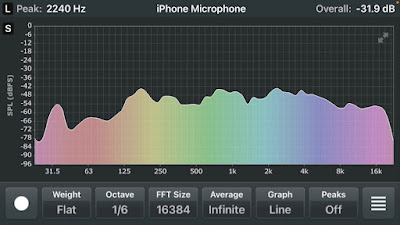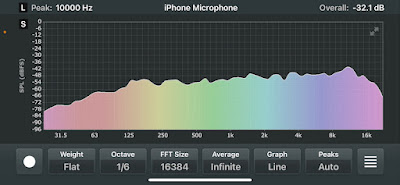 |
| from Western Electric Oscillator July 1947 |
Whether it's an open baffle as conceived by G.A. Briggs or an enclosed box like the Western Electric utility boxes above, I've always been an advocate for a wide baffle design. The wide frontal area serves as an acoustic reflector that helps propagate sound toward the listener instead of escaping to the sides and back. Somehow the wide baffle, whether open or closed, always makes reproduced music sound more alive to my ears!
A notable exception is the narrow front baffle Silbatone box designed by Dr. Stefano Bae for the Western Electric/Altec 755A. Since I uploaded the cabinet project under the auspices of Joe Roberts, it has garnered a following amongst DIYers who've reported successful results mounting other 8' drivers like the Altec 755C, 755E and the Lafayette SK98/Pioneer PIM8L.
I finally got a chance to mount and listen to my 755Cs and PIM8Ls + other 8" wide band drivers. Hopefully, this article will encourage readers to DIY this mini-monitor sized box because it really offers a lot of musical pleasure per cubic inch!
To recap, let's start with the...
Altec 755A
Ever since I started dabbling in DIY audio, I've been enjoying my treasured pair of Altec 755As. Whether it's mounted in an open baffle, 2 cf box and now, the Silbatone box, IMHO and experience, I have yet to find an 8" wide range driver which can equal its midrange sound quality, especially its ability to reproduce vocals with remarkable realism.
 |
| Silbatone box + Altec 755A |
FWIW, here's an iPhone RTA of the Altec 755A in the Dr. Bae/Silbatone box.
Although my buddy J-Rob hasn't been writing much these days, I highly recommend his Junkyard Jukebox blog for his musings about the Western Electric/Altec 755A, while good ole Frank does the music making here.
Since I didn't want to risk damaging my irreplaceable Altec 755As by constantly changing them in and out of their Silbatone boxes, I commissioned my friend at Hommage Audio to build another pair. This time, I specified a rough and ready version with extra blank front baffles so I can configure them for other 8" drivers. I had to learn how to cut a recess with my Jasper router jig because I decided to rear mount the drivers.
Altec 755C
I have a close affinity to this driver because it made me realize that there's a vast horizon of hifi beyond BBC voiced LS3/5As driven by PP EL84s and EL34s. The 755Cs were my gateway to high sensitivity speakers driven by flea powered SE-DHT amps.
 |
| Silbatone box + Altec 755C |
In spite of the greater top end specs, to my ears, there is less energy in the higher frequencies and less presence in the midrange compared to its older brother, the 755A. Although I'd agree with the improved bass extension, IME, 40Hz is a bit optimistic in this box, the 2 cf cabinet or the open baffle. The 755C retains much of the 755A character, with a bit less snap and sparkle.
If you don't have a 755A to compare it with, you'll already be impressed. Admittedly, comparing hifi components is a really fun aspect of this hobby. But what's the point of comparing something you can't find and afford vs. something more realistically attainable?
Although the 755C sounds perfectly fine without a super tweeter, the Altec 3000H adds that last bit of ambience and air. Unfortunately, 755C + 3000H doesn't = 755A.😞
Doesn't the IKEA blue Knarrevik look spiffy?😉
Pioneer PIM8L
I discovered this 8" duo-cone at a radio show in Lansing, MI in the 90s in the more deluxe Lafayette SK98 guise, which I deeply regret trading.😞 It can also be found branded as Pioneer PIM8L, PIM20 or Hamlin with either 8 or 16 ohm voice coil. Regardless of what brand it sports, I regard this wide band 8" very highly!
 |
| Silbatone box + Pioneer PIM8L |
High frequencies can beam, but on-axis it has more HF energy than the 755C and possesses a similar 3D midrange. Just watch out for rubbing voice coils, damaged/torn suspensions and heed the Pioneer specified 6W maximum rating!
Unfortunately, both Altecs and the Pioneer are no longer easy to find and when available, are very costly! So what are the alternatives?
The following drivers don't have the gravitas of the Altecs and the Pioneer. But they are easier to find and more affordable. They all offer great musical value for the money, IMHO!
Motorola Golden Voice 8

This Alnico 8" paper cone driver sounds fast with lots of snap from the bass to the top end with a vibrant midrange. But as I listened further, I became aware of a slight whizzer cone tizz. It projects a very lively and exciting sound, which reminds me of Lowthers!
 |
| Silbatone box + Motorola Golden Voice 8" |
Electro-Voice Wolverine LS8
Beyma 8AG/N
 |
| Silbatone box + Beyma 8AG/N |
However, if I split hairs, the midrange isn't quite as vivid as the Motorola GV8. Could that be an Alnico vs. Ferrite thing? That said, I wholeheartedly recommend this modern 8" wide band driver, which seems to have had some following in Germany but still under the radar stateside.
*UPDATES*
I received this comment on my YouTube channel regarding the Beyma 8AG/N:
Congratulations beautiful video! The Beyma 8 AG N is also recommended in the wonderful book about tubes and full-range loudspeakers "Highly Sensitive" by Dr. Götz Wilimzig. Unfortunately, Beyma has stopped production, so that only residual stocks are available. Regards Stefan
ElectroVoice 209-8A
Prompted by an inquiry from a reader regarding the EV 209-8A, I realized that I forgot to include it in this survey. Click here for my musings about this driver back in 2017. This model is also discontinued but I've seen NOS units on eBay starting below $15/each.
 |
| Silbatone box + EV 209-8A |
Its performance in the Silbatone box pretty much mimics how it behaved in the open baffle seven years ago. The midrange is quite vivid. There's no trace of harshness while the top end is rich and airy. However, it's not quite as dynamic or as extended and authoritative in the lower frequencies compared to the other drivers in this group.
Visaton BG20
 |
| Silbatone box + Visaton BG20 |
The amount of bass this driver was pumping out of the diminutive Silbatone box was quite surprising. If I had to nitpick, there's a bit of whizzer cone tizz that's only noticeable on brighter recordings. Its slightly recessed midrange gives it a modern and neutral tonal balance.
CODA
In this survey, I focused on midrange and upper frequency musical performance because I realized that 8" wide range drivers which worked well in my G.A. Briggs inspired open baffle, also produced satisfactory bass response in the Silbatone box. Therefore, it's safe to assume that 8" drivers with a Qts value close to 0.7 or greater, are suitable candidates for the Silbatone box.
Instead of obsessing with T/S parameters, be adventurous, have fun and experiment like my Instagram friend Andrew did below. Anyway being empirical is very much in line with this excerpt from J-Rob's comment in the original Silbatone 755 box article, "... My analysis of this untuned little cabinet is that it falls under the 'small box with a hole in it' design paradigm."














I am trying to do something similar in my country, where it is difficult to get any type of altec, however, there was a factory years ago here, Leea, that had some altec licenses, and made this speaker, the 812re 8ohm 8", With 92db sensitivity, 55hz to 15khz response, and the cabinet they recommend has similar measurements to the silbatone, do you think I could give it a try?
ReplyDelete
DeleteI've outlined the relevant technical parameters above and encourage people to be adventurous and experiment.
If the driver is cheap, sure. But only you can determine the cost/risk factor.
As the saying goes, "...nothing ventured, nothing gained."
Thank you, that will be my next project.
ReplyDeletePublic shout-out to JE for encouraging me to try these boxes with a couple of the PIM-6L/SK-98 drivers that have kind of gathered at my house. Auxiliary shout-out to my son who kindly (and excellently) built the boxes for me in Baltic birch. :) The midrange in particular is quite remarkable in quality. ... and, yes, JE, someday I will try the EV LS-8 twincones in 'em, too... so many drivers, so little time.
ReplyDeleteGlad to hear this Mark! Enjoy!
DeleteI have been obsessing about these boxes for a while, but I don't have any 8 inchers to try yet. Do you think they can be sized up or down to accommodate a 12" or 3-4" full ranger? I have an unused pair of Wharfedale Super 12, and a pair of Realistic Minimus 18 that have a pretty nice full range driver in them.
ReplyDeleteI wouldn't recommend messing around with the dimensions because AFAIK, this was an empirical design. See Joe Roberts comment in the main Silbatone 755 box article - https://jelabs.blogspot.com/2019/04/a-visit-to-j-robs-and-silbatone-755a.html
DeleteThanks! I have read that a number of times. I'm just trying to figure out what to do with some spare drivers I have and I really like the Silbatone design.
DeleteThat was me above. I forgot to use my name :)
Delete👍😊
DeleteHello dear Joseph,
ReplyDeleteIt always gives me great pleasure to read your article “Silbatone Box Adventure”.
Your friend at Hommage Audio has done a really good job with the Silbatone - Clone with alternating baffle. In my opinion, this case is even better from an acoustics point of view than the original Silbatone (Dr. Stefano Bae). With the sound wall screwed onto sealing tape, in contrast to the Silbatone box with glued sound wall, there is a division of the resonant outer surface into 3 surfaces (Silbatone 2), as is also done by Harbeth, for example.
Your friend also seems to have chosen softer plywood than birch plywood when choosing materials. See also:
https://www.inner-magazines.com/audiophilia/phy-e17-lb15/
Bernard Salabert told Kari Nevalainen: If there had to a cabinet it should be made preferably of soft spruce plywood, not of hard birch plywood. Old well-proven knowledge, this too. Birch plywood is more rigid but tends to resonate unpleasantly. He only recommended birch to be used if the wall was very thin, 3-5 mm, and braced inside with a similar plywood cuts.
The only remaining kinks could be a bevel about 10x45° around the speaker and an edge change while maintaining the net volume according to Harry F. Olson's "Acoustic Engineering."
https://pearl-hifi.com/06_Lit_Archive/02_PEARL_Arch/Vol_16/Sec_53/Audio/1951_Audio/Olson_On_Diffraction/Direct_Radiator_LS_Enclosures.pdf
Kind audiophile regards
Stefan
That's why I don't subscribe to the notion that there's such things as _the best_! There are too many variables.😊
Delete